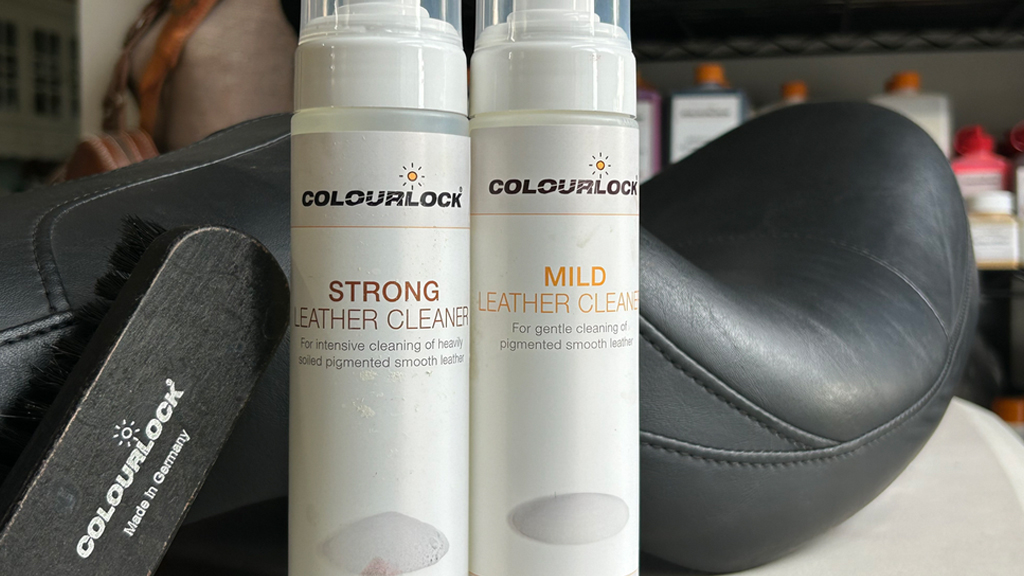Colourlock Leather Care products are manufactured in Germany, by parent company Lederzentrum. The undivided focus is leather care and repair. Manufacturing and supplying care & maintenance products as well as repair & restoration products that are kind to all leather types. (including vinyl and plastic)
Step-one into the cleaning processes is to inspect the surface, deciphering its overall condition and leather type. I’m using a stock 2001 Harley Davidson seat for demonstration. (Its made of vinyl, not leather) With age and vinyl as the variables, I’ll be using Colourlock Leather Cleaner Strong and the Leather Cleaning Brush. Considering the condition, the Mild Leather Cleaner would work just as well so there’s no wrong choice here if trying to decide which cleaner to use.
What’s the difference between Colourlock Mild and Strong Leather Cleaners?
The easy answer is, “Mild Leather Cleaner” is for newer leathers and “Strong Leather Cleaner” is for older leathers.
But what is it that’s separates the two cleaners from being different from one-another?
Mild Leather Cleaner is a perfect match for newer leathers or leathers that are commonly kept up with. It’s designed to be at the perfect pH that the leather surface desires. Which is around 4.5 – 5 pH.
Strong Leather Cleaner has a mild 4% increase due to a subtle solvent additive which effectively makes it stronger and slightly more efficient cleaner in use. The Strong Leather Cleaner is going to be more effective against sweat (body oils) soiled areas and dye transfer. Stubborn stains. etc.
Depending on the condition of what you’re cleaning, we recommend a Foam Cube or the Cleaning Brush. A foam cube would be used for light cleaning and minimal agitation and the Cleaning Brush for heavier agitation and deeper cleaning results.
Foaming nozzles are used to reduce the moister content that’s being applied to the surface.
We always want to apply the Leather Cleaner Directly to the brush for good practice apposed to applying it directly to the surface.
Agitation in this combo is where we’ll find the best results.
It’s best to stay working on one section at a time, one piece of the pattern at a time while working in small circular motions with medium to light pressure. We don’t want to scrub vigorously. Medium to light pressure is more than enough allowing the product and tool to do the work.
From one section to the next, wipe down the area with a cloth before moving to the next area.
We are lifting the dirts and oils from the surface in the process and when we wipe, we’re transfering the dirts and oils to a cloth.
I would recommend two ideas to explore.
1.) You can fold the towel/cloth to a clean section between each wipes to avoid smearing dirts and oils around.
2.) You can fill a small bucket with warm water to toss your cloth into after each wipe down. However, if doing this, wring the towel/cloth out very well before wiping the surface. I was taught this many years and it’s an interesting thing to try because you can physically see the dirts and oils that are being transferred. Basically, we’re cleaning the cloth as we go and all the dirts and oils are being transferred from the material surface to the warm bucket of water. It’s the oils that I find interesting as you’ll begin to see the rainbow coloring on the waters surface. It’s a conformation that even the transparent stuff we can’t see is being removed from the surface. But again, wring the cloth out well in-between wipes so it’s not fully saturated, dripping water when wiping. Reduced moister is best.
In the 50/50 below we can see everything is working and looking much better. The grayish dirt tone we’re seeing is the result of common dirts from friction and contact. normal wear & tear.
A simple cleaning on a surface that’s over 20 years old and has never been cleaned before looks brand new again, no problem!
Pigmented Surfaces:
A pigmented surface is colored surface. Both of these cleaners are perfectly safe on the pigmented surfaces.
If you’ve ever cleaned a leather surface such as a steering wheel or bolster and saw the color transfer to the towel when wiping it clean, this is very common and normal. The top-coat has been removed in these cases and all contact is taking place directly on the pigmented surface. If this is the case, Colourlock Cleaners are not causing any negative effects to the pigment. Stronger cleaners can cause more damage because they’re of a higher solvent base in most cases. Be careful with cleaners that are to strong.
Cleaning can be achieved in many ways but a good cleaning that doesn’t cause future issues is best for the longevity of our materials.
Thank you for checking out this article. You can find both of these cleaners and cleaning brush right here at Detailed Image!
If any questions, please don’t hesitate to ask.
